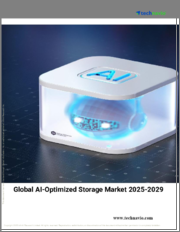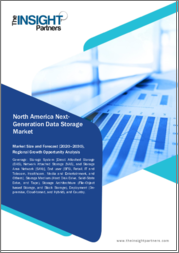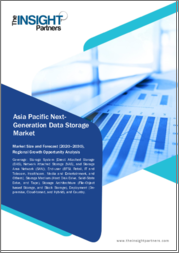
|
시장보고서
상품코드
1616395
세계의 차세대 데이터 스토리지 시장 규모 : 지역별, 범위 및 예측Global Next-Generation Data Storage Market Size By Vehicle Type, By Material, By Fuel Type, By Geographic Scope And Forecast |
||||||
차세대 데이터 스토리지 시장 규모와 예측
차세대 데이터 스토리지 시장 규모는 2024년에 734억 1,000만 달러로 평가되며, 2031년에는 1,338억 8,000만 달러에 달할 것으로 예측되며, 예측 기간인 2024-2031년의 CAGR은 7.80%로 성장합니다.
세계의 차세대 데이터 스토리지 시장 성장 촉진요인
차세대 데이터 스토리지 시장 시장 성장 촉진요인은 다양한 요인의 영향을 받을 수 있습니다.
데이터의 폭발: 디지털 기기, 소셜미디어, 사물인터넷(IoT) 용도, 온라인 거래의 확산으로 전 세계에서 생성되는 데이터의 양은 지속적으로 증가하고 있습니다. 이러한 급격한 데이터 증가로 인해 방대한 양의 데이터를 관리할 수 있는 독창적인 스토리지 솔루션이 요구되고 있습니다.
빅데이터 분석 :
빅데이터 분석다양한 산업 분야의 기업은 인사이트 있는 지식과 데이터베이스 의사결정을 위해 빅데이터 분석에 대한 의존도를 높이고 있습니다. 따라서 분석 프로그램에서 생성되는 데이터의 양, 다양성, 속도를 관리할 수 있는 고성능의 확장 가능한 스토리지 옵션이 요구되고 있습니다.
클라우드 컴퓨팅:
클라우드 컴퓨팅Infrastructure as a Service(IaaS), Platform as a Service(PaaS), Software as a Service(SaaS)와 같은 클라우드 컴퓨팅 서비스의 확산으로 확장 가능하고 합리적인 가격의 스토리지 솔루션에 대한 수요가 증가하고 있습니다. 확장 가능하고 합리적인 가격의 스토리지 솔루션에 대한 수요가 증가하고 있습니다. 클라우드 인프라는 분산 파일 시스템, 오브젝트 스토리지, 클라우드 네이티브 스토리지와 같은 차세대 데이터 스토리지 기술 없이는 작동하지 않습니다.
머신러닝(ML)과 인공지능(AI) :
학습과 추론을 위해 이 두 연구 분야는 방대한 양의 데이터를 필요로 합니다. 기업이 AI와 ML 알고리즘을 자주 사용하고, 절차를 자동화하고, 의사결정을 개선하고, 경쟁력을 확보하기 위해 AI와 ML 알고리즘을 사용함에 따라 대용량, 고성능 스토리지 솔루션의 필요성이 증가하고 있습니다.
엣지컴퓨팅:
엣지 컴퓨팅이 확산됨에 따라 데이터 소비 지점 및 소스에 더 가까운 곳에서 데이터를 처리하기 위해 분산 아키텍처를 지원하는 스토리지 시스템이 필요합니다. 네트워크 엣지에서는 엣지 스토리지 솔루션이 효율적인 데이터 처리, 실시간 분석, 저지연 데이터 액세스를 촉진합니다.
IoT와 5G:
5G 네트워크의 발전과 IoT 디바이스의 보급으로 센서, 디바이스, 연동 시스템에서 방대한 양의 데이터가 생성될 것으로 예상됩니다. 데이터 처리, 실시간 분석 및 집계와 같은 IoT 용도의 요구사항은 차세대 스토리지 솔루션으로 지원되어야 합니다.
데이터 거버넌스 및 규제 준수 :
캘리포니아 소비자 개인정보 보호법 및 일반 데이터 보호 규정과 같은 엄격한 법률과 규정은 안전하고 컴플라이언스를 준수하는 스토리지 솔루션을 요구하고 있습니다. 데이터 보안 및 법적 요건 준수를 보장하기 위해 데이터 스토리지 프로바이더들은 암호화, 데이터 마스킹, 액세스 제어, 감사 추적 등의 기능을 제공하는 독창적인 방법을 고안해내고 있습니다.
기술 혁신 :
차세대 데이터 스토리지 솔루션은 SSD(SSD), 비휘발성 메모리(NVM), 단일 자기 기록(SMR), 헬륨 충전 하드 디스크 드라이브(HDD), 스토리지 클래스 메모리(SCM)와 같은 스토리지 기술의 발전에 힘입어 추진되고 있습니다. 이러한 발전은 에너지 효율성, 성능, 신뢰성 및 스토리지 밀도를 향상시킬 수 있습니다.
컨테이너화 및 가상화:
컨테이너화된 용도과 가상화 기술의 사용은 데이터에 접근, 처리 및 저장하는 방식을 변화시키고 있습니다. 현대 IT 인프라의 변화하는 요구를 충족시키기 위해 차세대 스토리지 솔루션은 가상화 환경 및 컨테이너 오케스트레이션 플랫폼과 쉽게 상호 작용할 수 있어야 합니다.
사이버 보안 위협 :
사이버 공격의 고도화 및 빈도 증가로 인해 데이터 스토리지와 보안은 심각한 장애물이 되고 있습니다. 데이터 침해 및 무단 액세스에 대비하기 위해 차세대 스토리지 솔루션은 암호화, 인증, 침입 감지, 데이터 무결성 검증과 같은 강력한 사이버 보안 기능을 포함해야 합니다.
세계 차세대 데이터 스토리지 시장 성장 억제요인
차세대 데이터 스토리지 시장에는 몇 가지 요인이 억제요인으로 작용할 수 있습니다. 다음과 같은 요인들이 있습니다.
비용:
차세대 데이터 스토리지 솔루션으로 전환하기 위해서는 많은 인프라 투자와 교육 비용이 필요한 경우가 많습니다. 특히 예산이 한정된 스타트업이나 소규모 조직의 경우, 초기 비용 부담으로 인해 도입에 어려움을 겪을 수 있습니다.
호환성:
새로운 데이터 스토리지 기술의 도입은 현재 사용 중인 용도 및 시스템과의 비호환성으로 인해 방해가 될 수 있습니다. 차세대 솔루션이 조직의 현재 소프트웨어 및 하드웨어 환경과 완벽하게 호환되지 않는 경우, 조직은 해당 솔루션으로의 전환을 꺼릴 수 있습니다.
보안 리스크 :
보안 위험은 저장되는 데이터의 양과 복잡성에 따라 악화될 수 있습니다. 새로운 데이터 저장 기술이 이미 확립된 기술보다 안전하지 않다고 생각한다면, 조직은 도입을 꺼릴 수 있습니다.
규제 준수:
많은 조직, 특히 의료 및 금융과 같이 규제가 엄격한 산업에 종사하는 조직은 업계 표준 및 데이터 보호 규정을 준수하는 것이 필수적입니다. 규제 준수에 대한 의구심 때문에 차세대 데이터 스토리지 기술 도입이 지연될 수 있습니다.
데이터 마이그레이션의 과제:
대량의 데이터를 구식 스토리지 시스템에서 최신 플랫폼으로 마이그레이션하는 것은 어렵고 시간이 많이 걸립니다. 데이터 유출, 다운타임, 업무 중단 등 데이터 마이그레이션의 어려움으로 인해 조직은 새로운 스토리지 기술 도입을 망설일 수 있습니다.
성능 및 신뢰성:
차세대 데이터 스토리지 기술은 유연성, 확장성 등의 장점이 있지만, 안정성 및 성능에 대한 우려는 여전히 존재할 수 있습니다. 새로운 솔루션이 기존 스토리지 기술보다 더 나은 성능과 안정성을 제공한다는 확신이 없다면, 조직은 도입에 소극적일 수 있습니다.
벤더의 락인(Lock-in) :
일부 차세대 데이터 스토리지 시스템에는 독점 기술 및 벤더 종속성이 포함되어 있으며, 유연성이 떨어지고 특정 공급업체에 대한 의존도가 높아질 수 있습니다. 다른 시스템과의 상호 작용, 벤더 교체 등 조직의 미래 잠재력을 제한하는 솔루션의 채택을 주저하게 만들 수 있습니다.
지식 및 이해 부족:
많은 조직이 차세대 데이터 스토리지 기술의 잠재적 이점을 인식하고 이해하지 못하는 경우가 많습니다. 조직이 제공하는 가치를 이해하고, 오해와 회의적인 시각을 극복하기 위해서는 교육 및 홍보 캠페인이 중요합니다.
목차
제1장 서론
- 시장의 정의
- 시장 세분화
- 조사 방법
제2장 개요
- 주요 조사 결과
- 시장 개요
- 시장 하이라이트
제3장 시장 개요
- 시장 규모와 성장 가능성
- 시장 동향
- 시장 성장 촉진요인
- 시장 성장 억제요인
- 시장 기회
- Porter's Five Forces 분석
제4장 차세대 데이터 스토리지 시장 : 스토리지 유형별
- 직접 접속형 스토리지(DAS)
- 네트워크 접속형 스토리지(NAS)
- 스토리지 에어리어 네트워크(SAN)
제5장 차세대 데이터 스토리지 시장 : 스토리지 기술별
- 하드 디스크·드라이브(HDD)
- 솔리드·스테이트 드라이브(SSD)
- 올 플래시 어레이(AFAs)
- 하이브리드 플래시 어레이(HFA)
제6장 차세대 데이터 스토리지 시장 : 도입 유형별
- 온프레미스
- 클라우드 스토리지
- 하이브리드 스토리지
제7장 지역 분석
- 북미
- 미국
- 캐나다
- 멕시코
- 유럽
- 영국
- 독일
- 프랑스
- 이탈리아
- 아시아태평양
- 중국
- 일본
- 인도
- 호주
- 라틴아메리카
- 브라질
- 아르헨티나
- 칠레
- 중동 및 아프리카
- 남아프리카공화국
- 사우디아라비아
- 아랍에미리트
제8장 시장 역학
- 시장 성장 촉진요인
- 시장 성장 억제요인
- 시장 기회
- 시장에 대한 COVID-19의 영향
제9장 경쟁 구도
- 주요 기업
- 시장 점유율 분석
제10장 기업 개요
- Hewlett Packard Enterprise(HPE)
- NetApp
- Huawei Technologies
- Pure Storage
- Hitachi Vantara
- Micron Technology
- Western Digital
- Dell Technologies
- DataDirect Networks(DDN)
- Scality
- MinIO
- Cloudian
제11장 시장 전망과 기회
- 신규 기술
- 향후 시장 동향
- 투자 기회
제12장 부록
- 약어 리스트
- 전시와 참고 문헌
Next-Generation Data Storage Market Size And Forecast
Next-Generation Data Storage Market size was valued at USD 73.41 Billion in 2024 and is projected to reach USD 133.88 Billion by 2031, growing at a CAGR of 7.80% during the forecast period 2024-2031. Global Next-Generation Data Storage Market Drivers The market drivers for the Next-Generation Data Storage Market can be influenced by various factors. These may include: Data Explosion: The amount of data generated globally is constantly growing due to the widespread use of digital devices, social media, IoT (Internet of Things) applications, and online transactions. This exponential expansion calls for creative storage solutions that can manage enormous volumes of data.
Big Data Analytics:
To gain insightful knowledge and make data-driven decisions, businesses in a variety of industries are depending more and more on big data analytics. This calls for high-performance, scalable storage options that can manage the volume, diversity, and velocity of data produced by analytics programmes.
Cloud computing:
The demand for scalable and reasonably priced storage solutions is being driven by the broad use of cloud computing services, such as Infrastructure as a Service (IaaS), Platform as a Service (PaaS), and Software as a Service (SaaS). Cloud infrastructures cannot function without next-generation data storage technologies including distributed file systems, object storage, and cloud-native storage options.
Machine learning (ML) and artificial intelligence (AI):
For training and inference, these two fields of study require vast amounts of data. The need for high-capacity and high-performance storage solutions is growing as businesses use AI and ML algorithms more frequently to automate procedures, improve decision-making, and obtain a competitive edge.
Edge Computing:
As edge computing gains traction, processing data closer to the point of consumption or source necessitates storage systems that can accommodate distributed architectures. At the network edge, edge storage solutions facilitate efficient data processing, real-time analytics, and low-latency data access.
IoT and 5G:
It is anticipated that the development of 5G networks and the spread of IoT devices would produce enormous volumes of data from sensors, devices, and linked systems. IoT application needs, such as data processing, real-time analytics, and aggregation, must be supported by next-generation storage solutions.
Data governance and regulatory compliance:
Strict laws and rules, such the California Consumer Privacy Act and the General Data Protection Regulation, need secure and compliant storage solutions. In order to guarantee data security and adherence to legal requirements, data storage providers are coming up with creative ways to offer features like encryption, data masking, access controls, and audit trails.
Technological Innovations:
Next-generation data storage solutions are being driven by advancements in storage technologies, including solid-state drives (SSDs), non-volatile memory (NVM), shingled magnetic recording (SMR), helium-filled hard disc drives (HDDs), and storage class memory (SCM). Enhancements in energy efficiency, performance, dependability, and storage density are provided by these advancements.
Containerisation and virtualization:
The use of containerised apps and virtualization technologies is changing how data is accessed, handled, and stored. In order to satisfy the ever-changing needs of contemporary IT infrastructures, next-generation storage solutions must easily interact with virtualized environments and container orchestration platforms.
Cybersecurity Threats:
Data storage and security are severely hampered by the growing sophistication and frequency of cyberattacks. To guard against data breaches and unauthorised access, next-generation storage solutions need to include strong cybersecurity capabilities including encryption, authentication, intrusion detection, and data integrity verification.
Global Next-Generation Data Storage Market Restraints
Several factors can act as restraints or challenges for the Next-Generation Data Storage Market. These may include:
Cost:
Making the switch to next-generation data storage solutions frequently necessitates a large infrastructure and training expenditure. Adoption may be hampered by higher initial expenditures, especially for startups or smaller organisations with tighter budgets.
Compatibility:
The adoption of new data storage technologies may be impeded by incompatibilities with current applications and systems. If next-generation solutions are not fully compatible with an organization's current software or hardware environments, then the organisation may be reluctant to move to them.
Security risks:
Security risks are exacerbated by the volume and complexity of data being kept. If organisations believe new data storage technologies are less secure than more established ones, they could be reluctant to implement them.
Regulatory Compliance:
Many organisations, especially those engaged in highly regulated industries like healthcare and finance, find it imperative to adhere to industry standards and data protection rules. The adoption of next-generation data storage technologies may be slowed down by any doubts about regulatory compliance.
Challenges with Data Migration:
Transferring massive amounts of data from antiquated storage systems to cutting-edge platforms can be difficult and time-consuming. Organisations may be discouraged from implementing new storage technologies due to data migration difficulties such as data loss, downtime, and disruption to business operations.
Performance and Reliability:
Although next-generation data storage technologies have advantages like greater flexibility and scalability, there may still be issues with reliability and performance. If organisations are not persuaded that new solutions offer better performance and dependability than conventional storage techniques, they could be reluctant to implement them.
Vendor lock-in:
Proprietary technology or vendor lock-in may be included in some next-generation data storage systems, which can reduce flexibility and increase reliance on particular providers. Adopting solutions that limit an organization's future potential to interact with other systems or swap vendors may make them hesitant.
Lack of Knowledge or Understanding:
Many organisations might not be aware of or comprehend the potential advantages of next-generation data storage technology. In order to help organisations comprehend the value offer and get past any misconceptions or scepticism, education and awareness campaigns are crucial.
Global Next-Generation Data Storage Market Segmentation Analysis
The Global Next-Generation Data Storage Market is Segmented on the basis of Storage Type, Storage Technology, Deployment Type, And Geography.
Next-Generation Data Storage Market, By Storage Type
- Direct-Attached Storage (DAS):
- This refers to storage devices directly connected to a single computer system.
- Network-Attached Storage (NAS):
- NAS devices are connected to a network and can be shared by multiple devices.
- Storage Area Networks (SANs):
- SANs are high-performance networks designed specifically to connect storage devices to servers.
Next-Generation Data Storage Market, By Storage Technology
- Hard Disk Drives (HDDs):
- Traditional storage devices that use spinning disks to store data.
- Solid-State Drives (SSDs):
- Flash-based storage devices that offer faster performance than HDDs.
- All-Flash Arrays (AFAs):
- Storage systems composed entirely of SSDs, providing the highest performance.
- Hybrid Flash Arrays (HFAs)
- : A combination of HDDs and SSDs, offering a balance between performance and cost.
Next-Generation Data Storage Market, By Deployment Type
- On-Premise: S
- torage infrastructure is physically located at the customer's site.
- Cloud Storage:
- Storage is delivered as a service over the internet by a cloud storage provider.
- Hybrid Storage:
- A combination of on-premise and cloud storage solutions.
Next-Generation Data Storage Market, By Geography
- North America:
- Market conditions and demand in the United States, Canada, and Mexico.
- Europe:
- Analysis of the Next-Generation Data Storage Market in European countries.
- Asia-Pacific:
- Focusing on countries like China, India, Japan, South Korea, and others.
- Middle East and Africa:
- Examining market dynamics in the Middle East and African regions.
- Latin America:
- Covering market trends and developments in countries across Latin America.
Key Players
- The major players in the Next-Generation Data Storage Market are:
- Hewlett Packard Enterprise (HPE)
- NetApp
- Huawei Technologies
- Pure Storage
- Hitachi Vantara
- Micron Technology
4DS Memory Limited
- Adesto Technologies Corporation.
- Avalanche Technology
- Cypress Semiconductor Corporation.
- Everspin Technologies Inc.
- FUJITSU
- IBM Corporation
- Nantero.
- SAMSUNG
- Inspur
- Tintri
- Nutanix
- Seagate
- Western Digital
- Micron Technology
- Dell Technologies
- DataDirect Networks (DDN)
- Scality
- MinIO
- Cloudian
- SwiftStack
- DeepOcean.
TABLE OF CONTENTS
1. Introduction
- Market Definition
- Market Segmentation
- Research Methodology
2. Executive Summary
- Key Findings
- Market Overview
- Market Highlights
3. Market Overview
- Market Size and Growth Potential
- Market Trends
- Market Drivers
- Market Restraints
- Market Opportunities
- Porter's Five Forces Analysis
4. Next-Generation Data Storage Market, By Storage Type
- Direct-Attached Storage (DAS)
- Network-Attached Storage (NAS)
- Storage Area Networks (SANs)
5. Next-Generation Data Storage Market, By Storage Technology
- Hard Disk Drives (HDDs)
- Solid-State Drives (SSDs)
- All-Flash Arrays (AFAs)
- Hybrid Flash Arrays (HFAs)
6. Next-Generation Data Storage Market, By Deployment Type
- On-Premise
- Cloud Storage
- Hybrid Storage
7. Regional Analysis
- North America
- United States
- Canada
- Mexico
- Europe
- United Kingdom
- Germany
- France
- Italy
- Asia-Pacific
- China
- Japan
- India
- Australia
- Latin America
- Brazil
- Argentina
- Chile
- Middle East and Africa
- South Africa
- Saudi Arabia
- UAE
8. Market Dynamics
- Market Drivers
- Market Restraints
- Market Opportunities
- Impact of COVID-19 on the Market
9. Competitive Landscape
- Key Players
- Market Share Analysis
10. Company Profiles
- Hewlett Packard Enterprise (HPE)
- NetApp
- Huawei Technologies
- Pure Storage
- Hitachi Vantara
- Micron Technology
- Western Digital
- Dell Technologies
- DataDirect Networks (DDN)
- Scality
- MinIO
- Cloudian
11. Market Outlook and Opportunities
- Emerging Technologies
- Future Market Trends
- Investment Opportunities
12. Appendix
- List of Abbreviations
- Sources and References



















